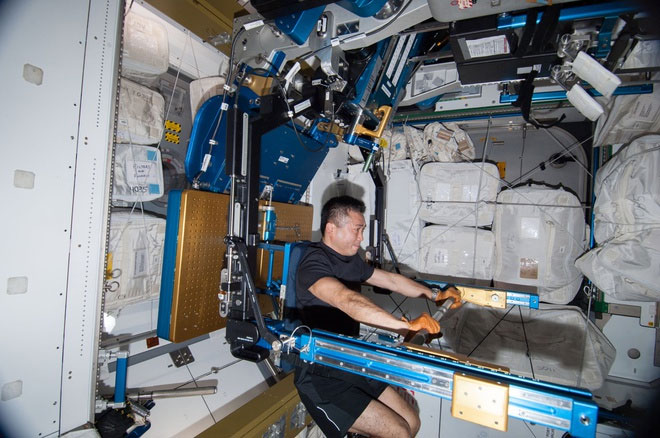Strange exercise equipment of astronauts in space
Living in a gravity-free environment, astronauts face the risk of osteoporosis, muscle loss and damage to the blood circulation.
On June 1, the Dragon Crew crew took two astronauts Robert Behnken and Douglas Hurley to the ISS International Space Station on SpaceX's Falcon 9 rocket. Mark the event of putting people on the ISS by the first private ship in history.
The human body, with the same reflexes of muscle groups, is developed under the influence of Earth's gravity. When on the ground, humans use a lot of force to walk, stand and grasp objects.
Living in space without gravity, the astronauts face the risk of osteoporosis and reduced muscle mass because most of the time they are hovering, do not use too much force to live.
According to The Verge, astronauts must train 90-120 minutes a day, 6 days a week to protect the body from changes when living in a gravity-free environment.

Astronauts must tie themselves to the rubber band to prevent it from drifting away from the treadmill. (Photo: NASA).
The International Space Station is equipped with 3 exercise machines including: a bicycle, a treadmill and a weightlifting machine called ARED. Each machine will have the function of serving each body part.
- Treadmill is designed as a normal treadmill. Astronauts are forced to attach their bodies to a rubber strap system, which keeps them from drifting off the treadmill. They will then try to slip on a running table, which is good for the heart and helps improve blood circulation.
- Bicycle is designed without a seat. Instead, the astronaut will lean on the pad at the back, keeping the body fixed with the handles on the sides. This device helps astronauts practice the entire lower body such as the thighs, legs and feet
- Weights have no effect in a zero-gravity environment, so ARED uses a vacuum cylinder to simulate weight, helping astronauts perform the exercises to develop the chest, shoulder and buttock muscles.

Weightlifting machine uses vacuum cylinder to simulate weight. (Photo: NASA).
According to NASA, when living outside the Earth, muscle mass will decrease by 11-17% and bone mineral density will decrease by 2-7% in every 180 days. Therefore, exercise plays a very important role to maintain the health of astronauts.
In addition to muscular and skeletal changes, ISS staff also experience effects related to the movement of blood in the body. When living in a zero-gravity environment, the blood and body fluids can move backward to the head, causing circulatory disorders or affecting vision.
However, most of the health problems mentioned above are temporary and will disappear when the astronauts return to Earth.
- Close-up of NASA astronaut exercise equipment
- Special items of astronauts on the space station
- Video: Two NASA astronauts step out into space
- The US spends $ 55 million on NASA to promote the creation of space for astronauts
- Space smells strange
- Trend of buying exercise machines at home
- Video: The prosecuted astronaut uses his hand to glow UFO near ISS station
- Why are astronauts forbidden to drink in outer space?
- China will let astronauts eat rice in space
- When astronauts fly into space, astronauts will be thinner
- America spends more on Russian rents to bring people to space
- The best exercise times
 Van Allen's belt and evidence that the Apollo 11 mission to the Moon was myth
Van Allen's belt and evidence that the Apollo 11 mission to the Moon was myth The levels of civilization in the universe (Kardashev scale)
The levels of civilization in the universe (Kardashev scale) Today Mars, the sun and the Earth are aligned
Today Mars, the sun and the Earth are aligned The Amazon owner announced a secret plan to build a space base for thousands of people
The Amazon owner announced a secret plan to build a space base for thousands of people